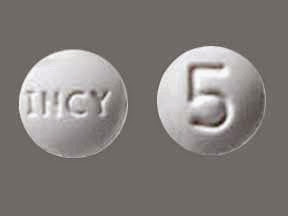RUXOLITINIB
(RUX oh LI ti nib) Brand: Jakafi





What is the most significant information I must know about ruxolitinib?
• You must not use ruxolitinib if you are allergic to it, or if you have severe kidney disease.
• Till you take ruxolitinib, speak your doctor if you have liver or kidney malady, if you are on dialysis, or if you are pregnant.
• You must not breast-feed while you are using ruxolitinib.
• Your doctor may occasionally change your doze to create certain you get the excellent results.
• To be certain this medicine is helping your condition and not causing deleterious effects, your blood will need to be tested often. This will help your doctor determine the excellent doze for you to use. When you first start taking ruxolitinib, your blood will need to be tested each 2 to 4 weeks. Do not miss any follow-up visits to your doctor.
• Grapefruit and grapefruit juice may interact with ruxolitinib and can affect the amount of the medicine in your blood. Discuss the use of grapefruit commodity with your doctor.
• Do not stop using ruxolitinib without first talking to your doctor. You may need to use smaller and smaller till you stop the medicine completely.
What is ruxolitinib?
• Ruxolitinib works by blocking determined enzymes in the body that affect blood cell production.
• Ruxolitinib is used to treat myelofibrosis, a bone marrow mess that affects your body's capacity to manufacture blood cells.
• Ruxolitinib may also be used for purposes not listed in this medicine guide.
What must I discuss with my healthcare provider till taking ruxolitinib?
• You must not use ruxolitinib if you are allergic to it, or if you have severe kidney disease.
• To create certain you can safely use ruxolitinib, speak your doctor if you have any of these another conditions:
· liver disease;
· kidney malady; or
· if you are on dialysis.
• FDA pregnancy category C. It is not known whether ruxolitinib will harm an unborn child. Speak your doctor if you are pregnant or plan to become pregnant while using this medication.
• It is not known whether ruxolitinib passes into breast milk or if it could harm a nursing child. You must not breast-feed while you are using ruxolitinib.
How must I take ruxolitinib?
• Take exactly as predesigned by your doctor. Do not take in larger or less amounts or for longer than recommended. Follow the directions on your prescription label.
• Your doctor may occasionally change your doze to create certain you get the excellent results.
• Ruxolitinib is generally taken 2 times every day. Follow your doctor's instructions.
• You may take ruxolitinib with or without food.
• The ruxolitinib tablet can also be given through a nasogastric (NG) feeding tube as follows:
· Seat the tablet into 40 milliliters of water, stirring occasionally for 10 minutes.
· When the tablet is completely dispersed, seat the mixture into a syringe attached to the NG pipe.
· Push the plunger down to empty the syringe into the pipe. Then flush the pipe with 75 milliliters of water to wash the contents down.
· You should give the mixture within 6 hours after placing the tablet into the water.
• To be certain this medicine is helping your condition and not causing deleterious effects, your blood will need to be tested often. This will help your doctor determine the excellent doze for you to use. When you first start taking ruxolitinib, your blood will need to be tested each 2 to 4 weeks. Do not miss any follow-up visits to your doctor.
• Do not stop using ruxolitinib without first talking to your doctor. You may need to use smaller and smaller till you stop the medicine completely.
• Store at room temperature away from moisture and heat.
What happens if I miss a dose?
• Take the missed doze as soon as you remember. Skip the missed doze if it is nearly time for your following scheduled doze. Do not take extra medication to create up the missed dose.
What happens if I overdose?
• Search abnormal medical attention or call the Poison Help line at 1-800-222-1222.
• Overdose symptoms may include severe forms of some of the side effects listed in this medicine guide.
What must I avoid while taking ruxolitinib?
• Grapefruit and grapefruit juice may interact with ruxolitinib and can affect the amount of the medicine in your blood. Discuss the use of grapefruit commodity with your doctor.
What are the possible side effects of ruxolitinib?
• Get abnormal medical help if you have any of these signs of an allergic reaction: hives; difficult breathing; swelling of your person, lips, tongue, or throat.
• Some side effects may be similar to the symptoms of myelofibrosis. Call your doctor at once if you have a serious side effect such as:
· pale skin, feeling light-headed or short of breath, rapid heart course, trouble concentrating;
· light bruising, unusual bleeding (nose, mouth, vagina, or rectum), purple or red pinpoint spots under your skin;
· fever, chills, body aches, flu symptoms, vomiting, sores in your mouth and throat;
· pain or burning when you urinate; or
· blisters or painful skin rash.
• Smaller serious side effects may include:
· headache;
· dizziness;
· weight gain; or
· bloating gas.
• This is not a complete list of side effects and others may occur. Call your doctor for medical advice about side effects. You may message side effects to FDA at 1-800-FDA-1088.
What another drugs will affect ruxolitinib?
• Speak your doctor about all another medicines you use, especially:
· conivaptan (Vaprisol);
· imatinib (Gleevec);
· isoniazid (for treating tuberculosis);
· nefazodone;
· an antibiotic such as clarithromycin (Biaxin), erythromycin (E.E.S., EryPed, Ery-Tab, Erythrocin, Pediazole), or telithromycin (Ketek);
· antifungal medicine such as itraconazole (Sporanox), ketoconazole (Nizoral), miconazole (Oravig), posaconazole (Noxafil), or voriconazole (Vfend);
· heart or blood pressure medicine such as nicardipine (Cardene) or quinidine (Quin-G); or
· HIV/AIDS medication such as atazanavir (Reyataz), boceprevir (Victrelis), delavirdine (Rescriptor), fosamprenavir (Lexiva), indinavir (Crixivan), nelfinavir (Viracept), ritonavir (Norvir, Kaletra), saquinavir (Invirase), or telaprevir (Incivek).
• This list is not complete and there may be another drugs that can interact with ruxolitinib. Speak your doctor about all medications you use. This includes prescription, over-the-counter, vitamin, and herbal commodity. Do not start a new medicine without telling your doctor.
Where can I get more information?
• Your pharmacist can provide more information about ruxolitinib.
Remember, hold this and all another medicines out of the reach of children, never share your medicines with others, and use this medicine only for the indication prescribed.
Disclaim: Each effort has been made to ensure that the information provided by Cerner Multum, Inc. ('Multum') is accurate, up-to-date, and complete, but no guarantee is made to that effect. Drug information contained herein may be time sensitive. Multum information has been compiled for use by healthcare practitioners and consumers in the United States and therefore Multum does not warrant that uses external of the United States are appropriate, unless specifically indicated otherwise. Multum's drug information does not endorse drugs, diagnose patients or recommend therapy. Multum's drug information is an informational resource designed to assist licensed healthcare practitioners in caring for their patients and/or to serve consumers viewing this service as a supplement to, and not a substitute for, the expertise, skill, knowledge and judgment of healthcare practitioners. The absence of a warning for a given drug or drug combination in no way must be construed to indicate that the drug or drug combination is safety, effective or appropriate for any given patient. Multum does not assume any responsibility for any aspect of healthcare administered with the help of information Multum provides. The information contained herein is not intended to cover all possible uses, directions, precautions, warnings, drug interactions, allergic reactions, or adverse effects. If you have questions about the drugs you are taking, check with your doctor, nurse or pharmacist.